| Reviews & Columns |
|
Reviews DVD TV on DVD Blu-ray 4K UHD International DVDs In Theaters Reviews by Studio Video Games Features Collector Series DVDs Easter Egg Database Interviews DVD Talk Radio Feature Articles Columns Anime Talk DVD Savant Horror DVDs The M.O.D. Squad Art House HD Talk Silent DVD
|
DVD Talk Forum |
|
|
| Resources |
|
DVD Price Search Customer Service #'s RCE Info Links |
|
Columns
|
|
|
Star Trek: The Original Series - Three Season Pack
The Show
Star Trek was not the first science-fiction television series about a crew of intrepid space explorers (Rocky Jones, Space Ranger proceeded it by 12 years), nor was it even the most popular such television series of its day (Lost in Space had twice the viewers), but in the years since, Star Trek has eclipsed every sci-fi show that came before and influenced every one that came after.
Though Star Trek was conceived as a grand space opera version of NBC's popular western frontier show Wagon Train, it was always more about the personal relationships of the characters than it was about futuristic technology and aliens. The USS Enterprise was captained by James Kirk, a brash, romantic, adventurer, modeled on C.S. Forester's Horatio Hornblower. The initial idea for the show was that Kirk's most important friendship would be with chief engineer Montgomery "Scotty" Scott, played by Irish-Canadian actor James Doohan. However, because the creators could not justify having the chief engineer on the bridge enough, it was decided to make the Vulcan first officer Spock (Leonard Nimoy) Kirk's closest confidant. Midway through the first season, chief medical officer Leonard McCoy (DeForest Kelly) was elevated to star billing as well when it was noted that his humane sentimentality was a useful foil for Spock's cold logic.
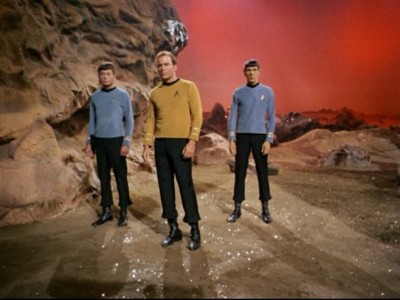 | 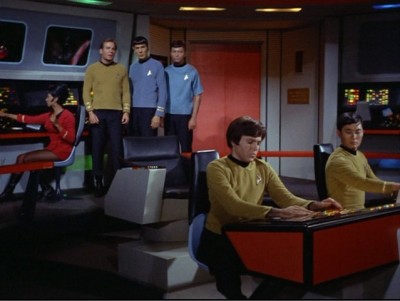 |
Though the show aired during the Cold War, series creator Gene Roddenberry envisioned a noble future in which the Earth was harmoniously united under a single world government, and he sought to reflect this in his crew. In addition to the American mid-west captain and southern doctor, Scottish engineer, and alien first officer, the principal characters included African communications officer Uhura (Nichelle Nichols), Asian helmsman Sulu (George Takei), and beginning in season two, Russian navigator Pavel Chekov (Walter Koenig).
Through the fiction of Star Trek, Gene Roddenberry offered dire warnings about the current state of human affairs, and hope for a better future. Star Trek posited that the Earth had suffered a horrible Third World War in the 1990s that nearly destroyed all mankind, and that it was the folly of this war that finally united all humanity. In the future posited by Roddenberry, everyone's basic needs are satisfied, money has lost its value, and racial and gender equality (or at least what passes for gender equality to the writers and creators of the show, themselves steeped in the culture of 1960's America) have been achieved.
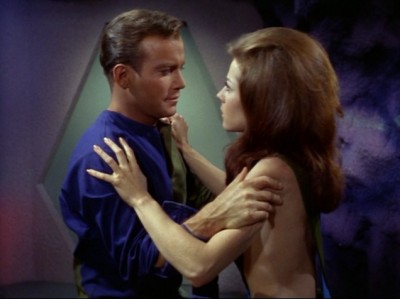 | 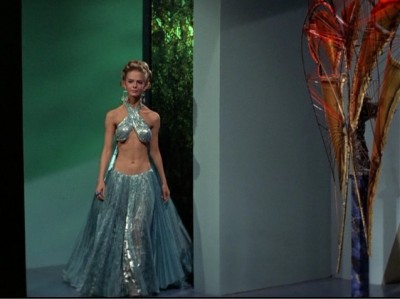 |
Star Trek pioneered many of the devices that became ubiquitous in subsequent sci-fi shows and movies: matter transporters, energy-absorbing electromagnetic shields, hand-held wireless communicators and PDAs, cloaking devices, computer speech synthesis, networked computers, laser surgery, and automated self-destruction devices, to name a few.
Among the many fine episodes, several truly shine:
- Episode 14, "Balance of Terror" (12/15/66) (directed by Vincent McEveety and written by Paul Schneider) - The USS Enterprise must intercept a Romulan Bird of Prey fitted with a powerful plasma weapon and cloaking device that's destroyed a series of Earth outposts before the Romulan ship can slip across the Neutral Zone. Borrowing from the conventions of submarine warfare films, this episode is also notable for introducing actor Mark Lenard who plays the Romulan captain here, but who returns to play other roles, most notably that of Spock's father in several subsequent episodes and movies.
- Episode 22, "Space Seed" (2/16/67) (directed by Marc Daniels and written by Gene L. Coon and Carey Wilber) - The USS Enterprise discovers a derelict Earth vessel in deep space with a cryogenically-frozen crew of 20th Century genetically-altered super-humans led by the tyrant Khan Noonien Singh (Ricardo Montalbán). Once revived, Khan tries to take over the Enterprise. Khan appears again in the movie Star Trek II: The Wrath of Khan.
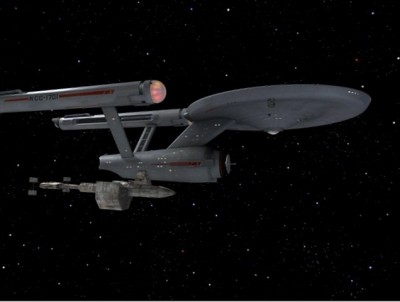
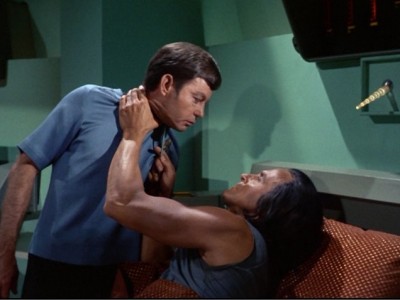
- Episode 25, "The Devil in the Dark" (6/15/67) (directed by Joseph Pevney and written by Gene L. Coon) - Kirk and Spock hunt down a creature that's been killing miners, but find their anthropocentric prejudices tested.
- Episode 28, "The City on the Edge of Forever" (3/6/67) (directed by Joseph Pevney and written by Harlan Ellison) - Kirk and Spock must follow a delusional McCoy through a time portal to 1930's New York City to prevent him from unintentionally changing history. The ending of this episode was uniquely downbeat for Star Trek.
- Episode 30, "Amok Time" (9/15/67) (directed by Joseph Pevney and written by Theodore Sturgeon) - Spock's façade of logic comes crashing down when he's gripped by an overpowering Vulcan mating drive that compels the Enterprise to go to his homeworld of Vulcan. On Vulcan, Kirk is forced to fight Spock to the death. Many of the best quotes from Trek come from this episode.
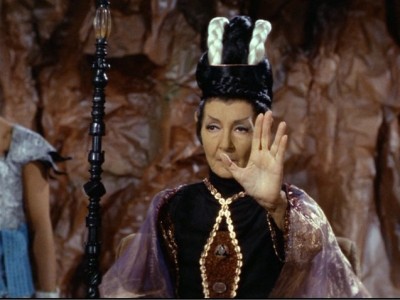
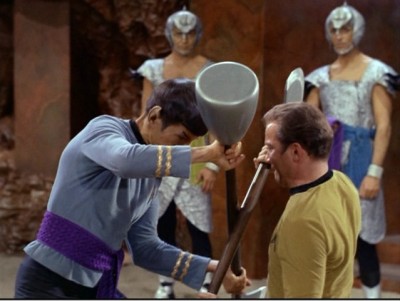
- Episode 33, "Mirror, Mirror" (11/06/67) (directed by Marc Daniels and written by Jerome Bixby) - A transporter mishap transposes Kirk, McCoy, Scotty, and Uhura with their vicious counterparts from an alternative reality. The four must make their way back to their own reality before they're exposed. The concept of mirror universes was carried forward in subsequent Trek series, and in other sci-fi series such as Stargate SG-1.
- Episode 35, "The Doomsday Machine" (11/20/67) (directed by Marc Daniels and written by Norman Spinrad) - After losing his own starship and crew to a planet-killing automated dreadnought, a crazed Commodore Decker (William Windon) usurps command of the Enterprise to fight on.
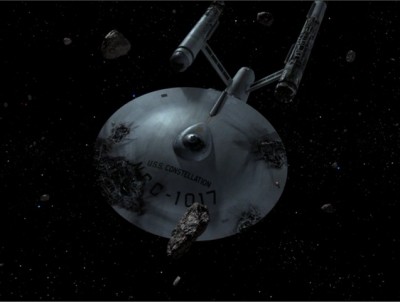
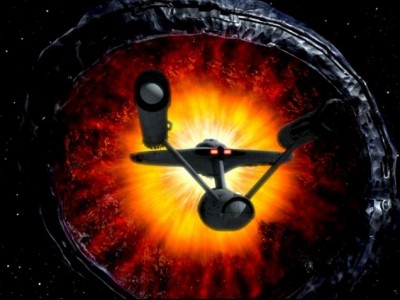
Star Trek suffered poor ratings throughout its three-year run. It avoided cancellation following its second season thanks largely to fan mail, but Roddenberry mostly gave up fighting for Trek after season two, leaving it to others to soldier on through a dismal third season with a slashed budget and a dreaded 10 PM Friday time-slot.
Following its cancellation at the end of season three, the devoted fans stayed with Star Trek through syndication and many more fans discovered it for the first time. As interest in Trek grew, a follow-up television series with the original cast was planned, but eventually abandoned in favor of movies. Ten Star Trek movies (six featuring most of the original crew) and five television series have followed to date with yet another Trek movie in the works. After nearly dying many times, the franchise continues.
The Remastering
The latest release of Star Trek: the Original Series is a significant improvement over the 2004 release with newly restored image and sound and new CGI effects.
| Original SD | SD Restoration | ||||||||||||||||||||||
|---|---|---|---|---|---|---|---|---|---|---|---|---|---|---|---|---|---|---|---|---|---|---|---|
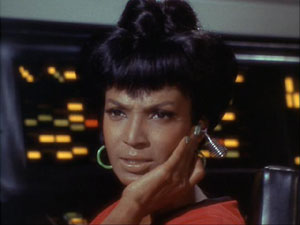 | 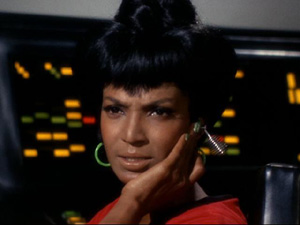 | ||||||||||||||||||||||
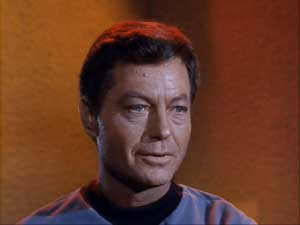 | 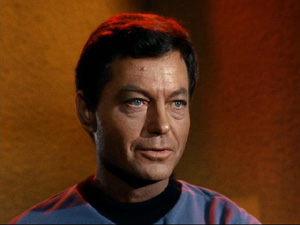 | ||||||||||||||||||||||
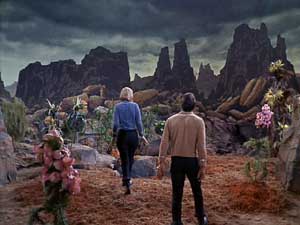 | 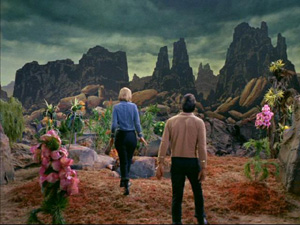 | ||||||||||||||||||||||
| Original SD | SD Enhancements |
|---|---|
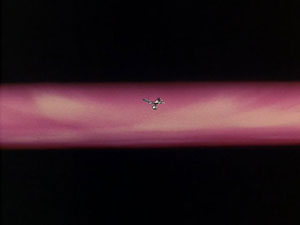 | 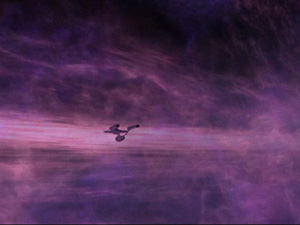 |
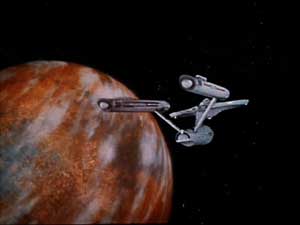 | 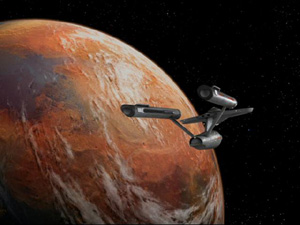 |
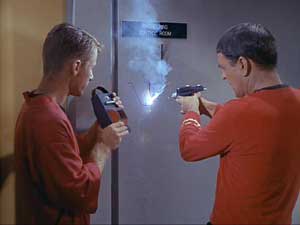 | 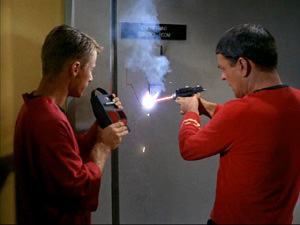 |
 |  |
| * These comparison images were generously provided by DVD Talk reviewer emeritus das Monkey from his review of Star Trek The Original Series - The Complete First Season (HD DVD). | |
Presentation
The fatal flaw of this release is the packaging which favors form over function. The discs, held on nearly non-existent hubs on thin plastic trays, are prone to coming loose and being scratched, especially on the ten-disc first set which features flippers with HD content on one side and SD content on the other. Many of the discs I received had come loose and three suffered scratches significant enough to interfere with playback.
Video:
The original series has never looked better. Remastered in their original aspect ratio of 1.33:1, the episodes shine. Colors are vibrant with accurate flesh tones and deep blacks. Focus, contrast, and detail are significantly improved over prior releases.
This is not to say the image looks perfect. There's still dirt here and there and a lot of grain, along with some new compression errors on the SD content but overall the improvement is substantial.
Truly impressive is the quality of the HD DVD material (1080p, MPEG-AVC encoded) on season one. Originally shot on film, the series benefits greatly from the increased resolution. Whole new levels of detail are visible from variations in Nimoy's makeup to loose threads on uniforms. So impressive is this HD content on season one, the otherwise excellent SD presentation on the DVDs looks drab by comparison.
Audio:
Audio is presented in Dolby Digital 5.1 (Dolby TrueHD for the HD-DVD discs of season one) with optional French and Spanish mono dubs also available. Like the picture, the audio for the series has been remastered and has never sounded better. Dialogue is crisp and distinct from score and effects. Though the mix is not as enveloping as it would be if the show was originally recorded for 5.1, it does make better use of the rear speakers than any prior release.
Optional subtitles are offered in English, French and Spanish.
Extras:
The remastered releases of Star Trek are packed with many hours of fine extras.
Season One:
- Starfleet Access (HD-DVD only) - trivia provided via onscreen text and short video clips that run currently with seven of the episodes.
- Interactive Enterprise Inspection (HD-DVD only) - a visual and audio tour of the functionality of elements of the starship Enterprise's hull.
- Billy Blackburn's Treasure Chest: Rare Home Movies and Special Memories (HD/SD 13 min.) - recollections and personal 8mm behind-the-scenes films of a supporting player who appeared in nearly every episode of the original series, frequently as Lt. Hadley but also as red shirts and costumed roles such as the white rabbit and Gorn Captain, and as DeForest Kelly's stand-in.
- Spacelift: Transporting Trek into the 21st Century (HD/SD 20 min.) - interviews with the team that updated the special effects and remastered the series for re-release, and demonstrations of their work. The remastering included cleaning up the image, adding new special effects, and rerecording the score.
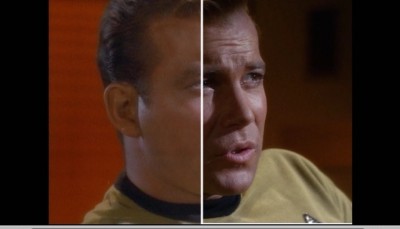
- Birth of a Timeless Legacy (SD 24 min.) - archival interviews with principal actors and producers of the series including series creator Gene Roddenberry, producer Robert Justman, and actors Bill Shatner and Leonard Nimoy.
- Reflections on Spock (SD 12 min.) - Leonard Nimoy reminisces about his role and the controversy and misunderstanding engendered by the title of his memoir I am Not Spock.
- Life Beyond Trek: William Shatner (SD 11 min.) - principally about Bill & Elizabeth Shatner's love of horses and competitive equestrian sports.
- Too Boldly Go . . . Season One (SD 19 min.) - a comprehensive retrospective of the first season with special emphasis on "Naked Time," the two-part "Menagerie," "Bad Seed," "Squire of Gothos," and "City on the Edge of Forever."
- Sci-Fi Visionaries (SD 16 min.) - Producer Robert Justman and story editor Dorothy C. Fontana reflect on their efforts to commission scripts from renowned sci-fi writers.
- Kiss 'n' Tell: Romance in the 23rd Century (SD 8 min.) - a mix of clips and interviews about the many love interests of Kirk, and the occasional romantic interests of the other characters, particularly Spock in "This Side of Paradise."
- Trekker Connections - A "Six Degrees of Separation" DVD-navigation game.
- Star Trek: Beyond the Final Frontier (SD 90 min.) - a History Channel documentary hosted by Leonard Nimoy about the series and its devoted fans.
- Star Trek Online Game Preview (SD 3 min.) - Promo spot for a forthcoming Star Trek MMORPG still in the concept stage.
- Star Trek Next Voyage previews - the original promo spots that appeared at the end of Star Trek episodes appear only on the SD sides of these discs.
- Five Collector Data Cards - these cards direct viewers to which episodes and features are on which discs.
- More Tribbles, More Troubles (24 min.) - Complete episode from Star Trek: The Animated Series with optional commentary by writer David Gerrold.
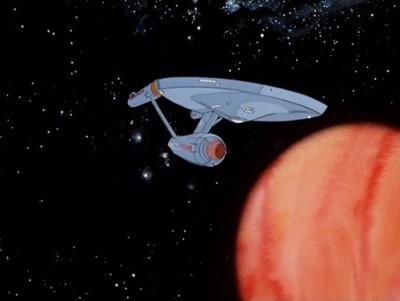
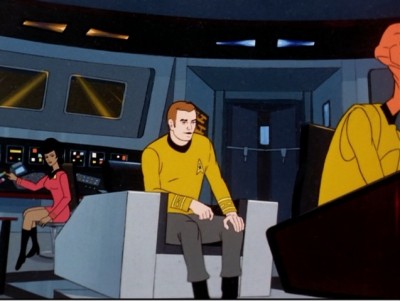
- Trials and Tribble-ations (45 min.) - Complete episode from Star Trek: Deep Space Nine.
- Billy Blackburn's Treasure Chest: Rare Home Movies and Special Features Part 2 (12 min.) - picks up where part one (listed above) left off.
- Text Commentaries - Two episodes feature pop-up text commentaries from Star Trek experts Michael & Denise Okuda.
- Too Boldly Go . . . Season Two (19 min.) - a retrospective of the second season with emphasis on "The Trouble with Tribbles," "Mirror, Mirror," the introduction of Walter Koenig, and the development of the backstory for Spock's Vulcan heritage.
- Life Beyond Trek: Leonard Nimoy (12 min.) - principally about Nimoy's personal and professional interest in photography.
- Kirk, Spock & McCoy: Star Trek's Great Trio (7 min.) - explores the strong bonds between Kirk, Spock, and McCoy.
- Star Trek's Divine Diva: Nichelle Nichols: (13 min.) - Nichols' reminiscences about her career, especially her memories about Star Trek.
- Designing the Final Frontier (22 min.) - a look at the set and prop designs by Matt Jefferies' art department.
- Writer's Notebook: D.C. Fontana (7 min.) - Dorothy Catherine "D.C." Fontana recalls her experiences as series writer and story editor.
- Star Trek's Favorite Moments (17 min.) - memories of favorite original Trek episodes from fans and actors, crew, and producers of subsequent Trek series.
- Star Trek Next Voyage previews.
- Four Collector Data Cards - these cards direct viewers to which episodes and features are on which discs.
- The Cage (63 min. & 71 min.) - the pilot Star Trek episode featuring Jeffrey Hunter as Captain Pike is presented in two cuts: the first is remastered with new special effects; the second features an extended cut with original black-and-white footage and an archival introduction and epilogue by Gene Roddenberry.
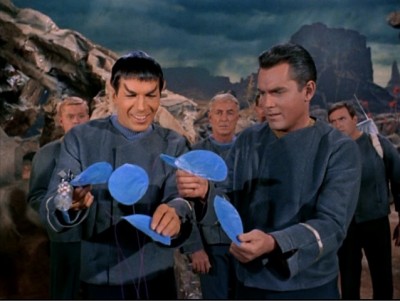
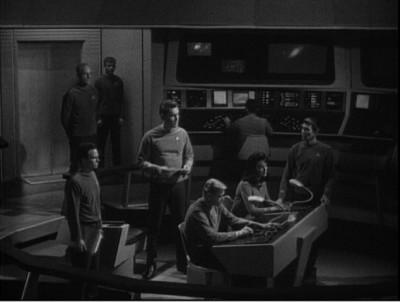
- Billy Blackburn's Treasure Chest: Rare Home Movies and Special Features Part 3 (11 min.) - the final installment in this extended look back at outtakes from the show hosted by ubiquitous extra Billy Blackburn.
- Too Boldly Go . . . Season Three (21 min.) - Discussion of letter-writing effort to save the show from cancellation following season two, the undermining efforts of the network, the departure of Gene Roddenberry and the rapid decline of series quality in season three, and episodes "Specter of the Gun," "Plato's Step-Children," and "Spock's Brain."
- Captain's Log: Bob Justman (9 min.) - the late Robert Justman (July 13, 1926 - May 28, 2008), series producer, is fondly remembered by his former colleagues.
- A Star Trek Collector's Dream Come True (7 min.) - Prop designer John Long demonstrates his hero replicas of original Trek phasers and communicators.
- Life Beyond Trek: Walter Koenig (11 min.) Koenig discusses his role as Chekov and his work since Trek including on Babylon 5, and his passion for collecting.
- Chief Engineer's Log (6 min.) - an archival interview with the late James Doohan about his role as Scotty.
- Memoir from Mr. Sulu (9 min.). George Takei discusses his character, his hope for an Excelsior series helmed by Captain Sulu (which was ultimately passed up in favor of Enterprise), and his professional and charitable work since Trek.
- Star Trek's Impact (9 min.) - Eugene Roddenberry discusses his father's legacy.
- Collectible Trek (14 min.) - discussion of the high prices paid for original Trek props and examples of the range of licensed toys and collectibles.
- Star Trek Next Voyage previews.
- Four Collector Data Cards - these cards direct viewers to which episodes and features are on which discs.
The only extras not provided that could substantially improve this set that come to mind would be audio commentaries with the surviving actors, crew, writers and producers.
Final Thoughts:
The newly remastered release of Star Trek: The Original Series available in this discounted three season pack is truly outstanding. Although my personal preference would be to buy the first two seasons and forgo the lesser third season, the only thing that keeps me from highly recommending this complete collection is the awful packaging which fails to keep the discs from coming loose. Be prepared to deal with badly scratched discs if you buy this set.
Here's hoping for better packaging on the inevitable Blu-ray release.
|
| Popular Reviews |
| Sponsored Links |
|
|
| Sponsored Links |
|
|
| Release List | Reviews | Shop | Newsletter | Forum | DVD Giveaways | Blu-Ray | Advertise |
|
Copyright 2024 DVDTalk.com All Rights Reserved. Legal Info, Privacy Policy, Terms of Use,
Manage Preferences,
Your Privacy Choices | |||||||












